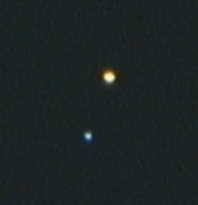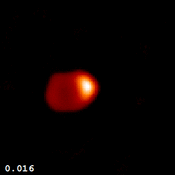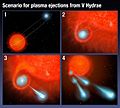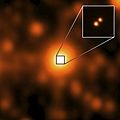Binary star facts for kids


A binary star is a system of two stars that orbit around each other. Think of them like two dancers spinning around a common center point! For each star, the other is called its companion star. Many stars in the universe are actually part of a system with two or more stars. The brighter star in a binary system is usually called the primary star, and the other is the secondary.
Binary stars are super important for astrophysics, which is the study of space. By watching how these stars orbit each other, scientists can figure out their masses (how much "stuff" they contain). This helps us understand how stars work and how big they really are.
It's important to know that binary stars are different from optical double stars. Optical double stars just look close together in the sky from Earth, but they aren't actually connected by gravity. They might be very far apart in space. Binary stars, however, are truly close and bound together by gravity.
The first person to discover and prove the existence of true binary stars was an astronomer named William Herschel. He started observing double stars in 1779 and published a list of about 700 of them. His son, John Herschel, later found thousands more and updated the list.
Contents
What Are Binary Stars?
Today, when we say binary star, we usually mean two stars that orbit a common center of mass. This is like the balance point between them.
Sometimes, a star seems to be orbiting empty space. This usually means its companion star is either very small and dim, or it's something super dense like a neutron star or a black hole. A famous example is Cygnus X-1, where the visible star's companion is thought to be a black hole.
The term double star is more general. It just means two stars that appear close together in the sky. These could be true binary systems, or they could be optical doubles – stars that just happen to be in the same line of sight but are actually very far apart.
Types of Binary Stars
Scientists classify binary stars based on how we observe them.
Visual Binaries
A visual binary star is one where you can actually see the two separate stars with a telescope. The brighter star is called the primary, and the fainter one is the secondary. Visual binaries often take a very long time to complete one orbit, sometimes hundreds or even thousands of years!
Spectroscopic Binaries
A spectroscopic binary is different. You can't see the two stars separately, even with a powerful telescope, because they are very close together. However, scientists can tell they are two stars by using a special tool called a spectroscope. This tool can detect tiny changes in the light from the stars, caused by the Doppler effect. As the stars move quickly toward or away from Earth, their light shifts slightly, telling us they are orbiting each other. These stars orbit very fast, sometimes in just a few days or weeks!
Eclipsing Binaries
Some spectroscopic binaries have an orbit that is perfectly lined up with Earth. When this happens, the stars will pass in front of each other, one by one. This is called an eclipsing binary. When one star blocks the light from the other, the total amount of light we see from the system dims slightly. It's like a mini-eclipse happening in space!
Astrometric Binaries
An astrometric binary is a system where we can only see one star. But this visible star seems to "wobble" as it moves across the sky. This wobble is caused by the gravitational pull of an invisible companion. By carefully measuring this wobble over many years, scientists can figure out the mass of the invisible companion and how long its orbit takes. This method is also used to find large planets orbiting other stars.
How Binary Stars Interact
Most binary stars are detached binaries. This means they are far enough apart that they only affect each other through their gravitational pull. They don't touch or share material.
However, some binaries are so close that one or both stars can pull material from the other. These are called contact binaries. They can even share the same outer layer of gas, called a stellar atmosphere. Over a very long time, as friction slows them down, they might even merge into one giant star! This merging event can cause a huge burst of light, making them shine much brighter than usual, though not as bright as a supernova.
How Binary Stars Form
It's very unlikely that binary stars form when two single stars just happen to pass close to each other. Instead, scientists believe that almost all binary stars are born together. They form at the same time within the dense gas clouds where new stars are created.
Runaway Stars and Novae
Sometimes, a passing star can disrupt a binary system. If the gravitational force is strong enough, it can even split the binary apart. These separated stars then go on to live as single stars. In some cases, the stars might be flung away from each other at incredibly high speeds, becoming what we call runaway stars.
Another interesting thing happens when a star orbits a white dwarf star. A white dwarf is the leftover core of a dead star. If the companion star is big enough and close enough, the white dwarf's strong gravity can pull gases from its companion's atmosphere. Over time, a lot of gas can build up on the white dwarf's surface. When enough gas collects, it gets so hot and dense that it explodes in a sudden burst of light, called a nova. This explosion doesn't destroy the white dwarf, and the process can repeat.
In even rarer cases, the white dwarf might gather so much gas that the explosion completely destroys it. This is a much bigger explosion called a supernova. A supernova can also create runaway stars, as the surviving companion star no longer has a heavy partner to keep it in orbit.
X-Ray Binaries
Some binary systems produce huge amounts of X-ray radiation. These are called X-ray binaries. They usually involve a very massive star and a very compact star (like a neutron star or black hole). The massive star "donates" its matter, which gets pulled towards the compact star. As this matter falls in, it heats up incredibly hot and releases powerful photons, including X-rays. X-rays can also come from the surface of the compact star during a process called thermonuclear burning, which can create bright bursts of X-rays.
Images for kids
-
An artist's drawing of plasma ejections from V Hydrae.
-
An artist's idea of what it might look like from a moon orbiting a planet in a triple star system. The brightest companion star is just below the horizon.
-
Luhman 16, the third closest star system to us, contains two brown dwarfs.
See also
 In Spanish: Estrella binaria para niños
In Spanish: Estrella binaria para niños










